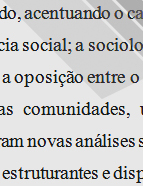

................................
Starting with Paulo Merêa (see previous references), responsible for dealing with “social organisation and public administration”, he analyses the institutional framework, seeking to capture and characterise the social fabric and th s resulting from the country’s legal order. He outlines the “feudal system” with an approach to the legal system of property and social groups. The “central administration” is characterised with rigour and detail, analysing the functions and powers of the main court officials, the king’s advisory bodies (the royal court and council), and also the organisation and functioning of the higher courts. The Cortes are discussed in depth with regard to their origin, composition, powers and political value. Local administration and municipal institutions are the subject of a separate chapter, where Herculano’s influence is expressly mentioned. It provides a complete picture of the municipalities and municipal officials, as well as the representatives of the central power at the municipal and regional level (corregedores), drawing attention to the disparities between the north and south of the country in the early days of the monarchy. The sources of law and judicial institutions are analysed separately, as is the legal status of Jews and Moors. In short, it can be said that it goes far beyond a merely legal view of institutions and seeks to capture their functioning and the role they played in society.
Another, Damião Peres (1889/1976, UP and UC), in addition to directing the work, is also the author (and in some cases co-author) of the chapters on political history from the second to the fifth periods. His analysis focuses mainly on the liberal period, whose institutional approach is diluted in the overall political history, characterised by long descriptions of events, facts and personal attitudes of the most relevant political figures. Political and administrative institutions are addressed in terms of their functioning and not in the legal and regulatory framework that governs them. Dealing with a period in which three constitutional texts were approved (the Constitutions of 1822 and 1838 and the Constitutional Charter of 1826), nowhere are the constitutional norms or the differences between them analysed, making it necessary to grasp them, in a diffuse way, in the descriptions that give an account of their functioning or of the political episodes that take place within them. For example, when reporting on the approval of the 1838 Constitution, it states that the new constitutional statute, “abandoning the radicalism of the 1822 Constitution, was no less distant from the Constitutional Charter with regard to the prerogatives of the Crown”, without, however, describing any of the texts in question (Vol. VII, p. 271). If the central power is not characterised in its legal and institutional contours, even less so are the judicial, administrative or military institutions. In the period corresponding to the First Republic and the beginning of the Estado Novo, which constitutes the Supplement published in 1954 (almost 20 years after the last volume, which ended with the First World War), central power is addressed in greater detail. The analysis covers not only the 1933 Constitution, in the contours it establishes for the organisation of central power, but also the legislation derived from it, namely the National Labour Statute and the regulations governing the People’s Houses, Guilds and National Trade Unions. It does not analyse the institutions of the peripheral administration of the State.
This work is financed by national funds through FCT - Foundation for Science and Technology, I.P, in the scope of the projects UIDB/04311/2020 and UIDP/04311/2020.
